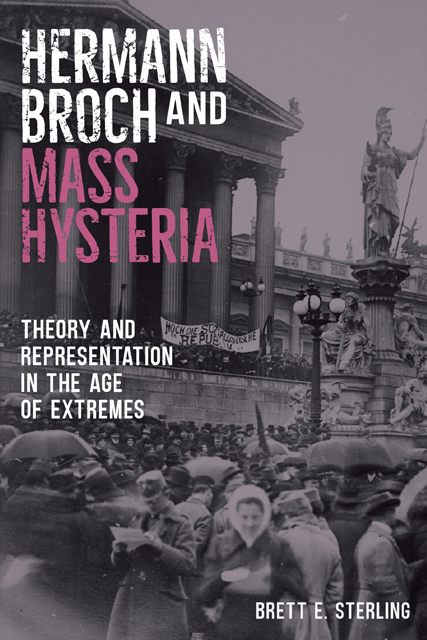Book contents
- Frontmatter
- Dedication
- Contents
- Acknowledgments
- List of Abbreviations
- Introduction
- 1: First Encounters, 1918–1929
- 2: The Power of Literature
- 3: The Mass Takes Shape: Literary Representations
- 4: Theory and Its Discontents: The Massenwahntheorie
- 5: The Threshold of Experience: Die Verzauberung
- Conclusion
- Bibliography
- Index
3: - The Mass Takes Shape: Literary Representations
Published online by Cambridge University Press: 11 January 2023
- Frontmatter
- Dedication
- Contents
- Acknowledgments
- List of Abbreviations
- Introduction
- 1: First Encounters, 1918–1929
- 2: The Power of Literature
- 3: The Mass Takes Shape: Literary Representations
- 4: Theory and Its Discontents: The Massenwahntheorie
- 5: The Threshold of Experience: Die Verzauberung
- Conclusion
- Bibliography
- Index
Summary
With the publication of “Die Straße” in 1918, Broch addressed the mass for the first time, a concept that would prove to be of importance for the bulk of his writing. In his first novel, the mass resurfaces, marking the beginning of an extensive occupation with the phenomenon. As Broch’s literary career developed, the mass became increasingly central to the content of his work, especially in the unfinished and posthumously published novel Die Verzauberung, a work fundamentally concerned with the circumstances and results of mass hysteria. Despite extensive research on Broch, representations of the mass in his fiction have been largely overlooked. When they have been addressed, it has most often been with reference to Die Verzauberung or to Broch’s Massenwahntheorie, which will be discussed in chapter 4. To illustrate the importance of the mass and its articulation as a literary figure in Broch’s writing outside of Die Verzauberung, this chapter will analyze scenes of mass events in three novels—Esch oder die Anarchie (1931), Die Unbekannte Größe (1933), and Der Tod des Vergil (1945)—and one drama, Die Entsühnung (1932). As will be shown, he accorded greater importance to the mass in each subsequent work, and in turn described it in ever greater detail.
My analysis proceeds according to the narrative proximity to the mass in each of Broch’s depictions. While I follow a roughly chronological progression, I have reserved Die Verzauberung—the first and only complete version of which was finished in 1936—for closer examination in the book’s closing chapter. In reading specific passages from these other fictional works, I demonstrate Broch’s move from the mass as a passive and incipient entity to an active, threatening force capable of violence and cruelty. Throughout the intensification of his treatment of the mass, he employs a range of techniques including those elaborated in the previous chapter—ambiguity, immediacy, and simultaneity—to vary the hermeneutic relationship of the mass to the reader. In the process, the reading experience can replicate identification with the irrational agency of the mass, which finds its apex in Die Verzauberung. In order to analyze Broch’s specific attempts at representing the mass, it is necessary first to address the specific difficulties involved in capturing such an ephemeral phenomenon in writing.
- Type
- Chapter
- Information
- Hermann Broch and Mass HysteriaTheory and Representation in the Age of Extremes, pp. 75 - 105Publisher: Boydell & BrewerPrint publication year: 2022



